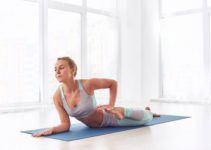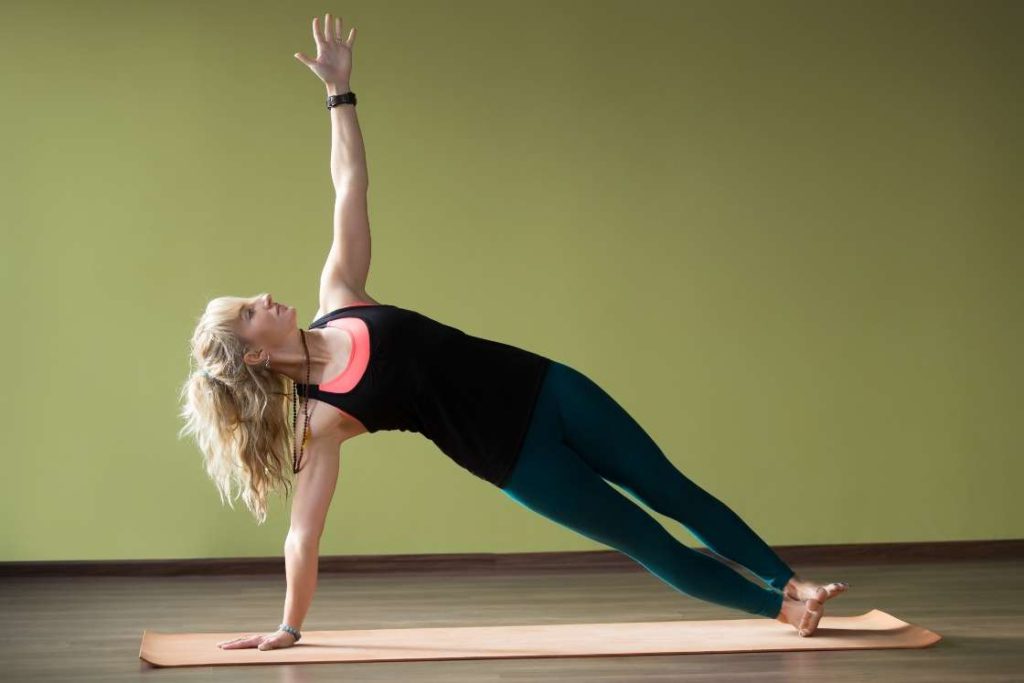
Scoliosis is a spinal disorder that curves the spine sideways and can be experienced by anyone regardless of their age and gender. Being a postural disorder, the curvature of each spine having scoliosis will be unique and needs specific treatment.
Yoga with some specific poses and pranayama can be used to correct Scoliosis once the spinal curve and pattern of scoliosis are known.
Scoliosis experts like Dr. Andrew Strauss claim that practicing yoga for scoliosis is effective in regaining the neutral spine and alleviating the associated back pain.
Common Symptoms of Scoliosis
- Abnormal sideways curvature of the spine (S or C shape)
- Uneven shoulders or waist
- One shoulder blade appearing more prominent than the other
- One hip higher than the other
- Back pain or discomfort (in some cases)
- Fatigue, especially after prolonged periods of sitting or standing
- Reduced mobility and flexibility in the spine
- Breathing difficulties in severe cases (when scoliosis affects lung function)
Benefits of Yoga for Scoliosis
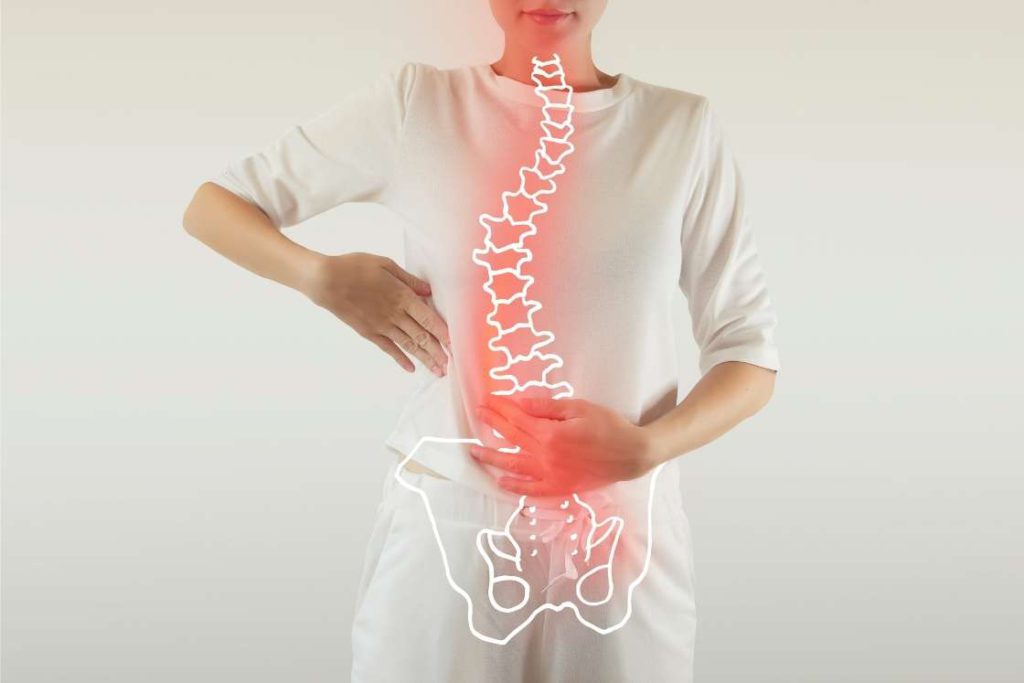
A 2007 report proves that practicing Iyenger Yoga is beneficial for scoliosis treatment and also strengthen the spine. In Iyengar yoga, different yoga props like a bolster, rope wall support, etc. are used to support the curved side of the spine. It has also seen, practicing Iyengar yoga eases Scoliosis pain to a great extent as compared to normal yoga.
Scoliosis curves the spine asymmetrically that is measured as a cobb angle taking reference from the most tilted vertebrae. Therefore, it is indispensable to do a yoga pose that suits your spinal curve and aims to reduce the Cobb angle.
Besides strengthening the spine, other benefits of yoga are there which are beneficial to cure scoliosis. It includes:
- The stretches that the spine undergoes in the yoga postures release the tension of the intervertebrae. In this way, yoga reduces the Cobb angle and straightens the spine.
- The curved spine position tends to weaken the surrounding muscles which can be strengthened by practicing suitable yoga for scoliosis.
- Yoga also strengthens the core muscles which act as a support system for the spine.
- Yoga helps in alleviating the back pain arising from scoliosis.
- It enhances the mobility and flexibility of the spine.
- Yoga for scoliosis works towards improving or maintaining the spinal position intact to cure or prevent the chances of getting scoliotic deformity.
Points You Should Know Before Doing Yoga for Scoliosis
Certain styles of yoga can have therapeutic effects on scoliosis. However, it is crucial to consider specific precautions before practicing yoga for scoliosis.
In Scoliosis, there are several poses that should be avoided, such as shoulder stands, cobra pose, fish pose, Triangle Pose and others. This avoidance is necessary to reduce the risk of exacerbating spinal curvature and experiencing increased pain.
Furthermore, here are the essential guidelines to follow if you intend to use yoga as a remedy for scoliosis.
- Recognize the specific scoliosis pattern developing within your spine to effectively choose yoga poses that counteract your curvature
- Keep in mind that mindful breathing is crucial for properly stretching tightened areas of your back and alleviating discomfort.
- Do not rely solely on yoga if you already have scoliosis as it can only relieve the symptoms but cannot halt the growing curvature.
- Practicing specialized scoliosis exercises along with yoga is important for patients with scoliosis.
- Understand that both sides of your spinal curvature will respond differently to every yoga move. So it’s okay to have an uneven depth of stretch in the same pose when practicing both sides.
- Involve those poses into your yoga for scoliosis which targets to stretch the concave side of your curve and simultaneously strengthen the convex side. This is to regain the symmetry within your spine and helps in improving balance.
- Do not push yourself to any pose that is beyond your range of mobility as the gist of practicing yoga remains the same even in yoga for scoliosis which is to practice as per your potential and reach.
Now, it’s time to jump into the poses that have been chosen to help people with scoliosis along with their mode of action to ease the spinal distortion.
Remember that individual experiences with yoga for scoliosis may vary, so it’s crucial to consult with a healthcare provider and work with a qualified yoga instructor to develop a practice that suits your specific needs.
10 Yoga Poses for Scoliosis
Yoga poses for scoliosis include basic standing stretching, balancing, and some advanced asymmetrical poses. All these yoga poses are intended to relieve pain, gain spinal re-alignment, promote flexibility, or enhance spinal strength.
Practice These Yoga Poses for Scoliosis:
- Side-Plank Pose
- Mountain Pose
- Tree Pose
- Cat-Cow Stretch
- Upward extended leg pose
- Cow-Face Pose
- Half Forward Bend
- Child pose
- Downward-Facing Dog Pose
- Side-Reclining Leg Lift Pose
1. Side Plank Pose
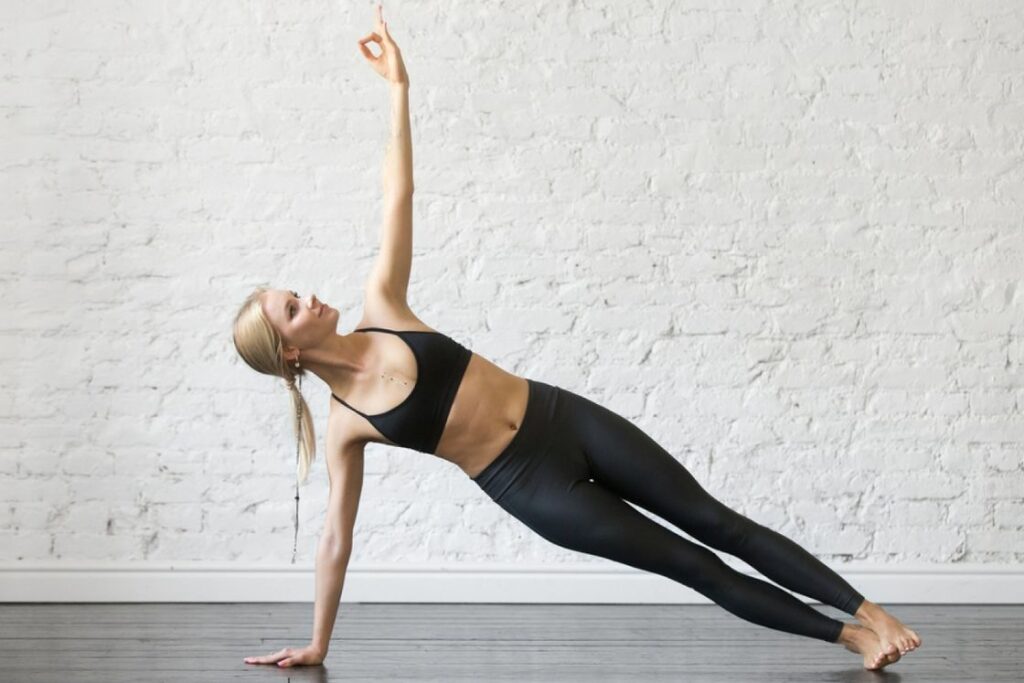
Side plank for scoliosis is the most effective asymmetrical balancing pose that has shown a significant reduction in the cobb angle of primary scoliotic curves in a 2014 research study.
Also known as Vasisthasana, this pose targets to strengthen the convex side of the spine that is successful in alleviating the curve. Hence, it is a must to do yoga for scoliosis for all the victims of this spinal disorder.
Procedure
- Begin with coming to your all fours and extending the legs straight to back curling your toes under assuming a plank pose.
- Keeping the core engaged, shift your weight towards the right foot.
- Lifting your left foot off the floor, stack it on top of the right.
- Rotate your torso towards the right opening your chest to the left.
- Along with this, gradually lift your left palms off the floor and raise them so that the fingertips point to the ceiling.
- Turn your neck to gaze to the raised fingertips.
- Stay there for five breaths then release to practice it on the other side.
2. Mountain Pose
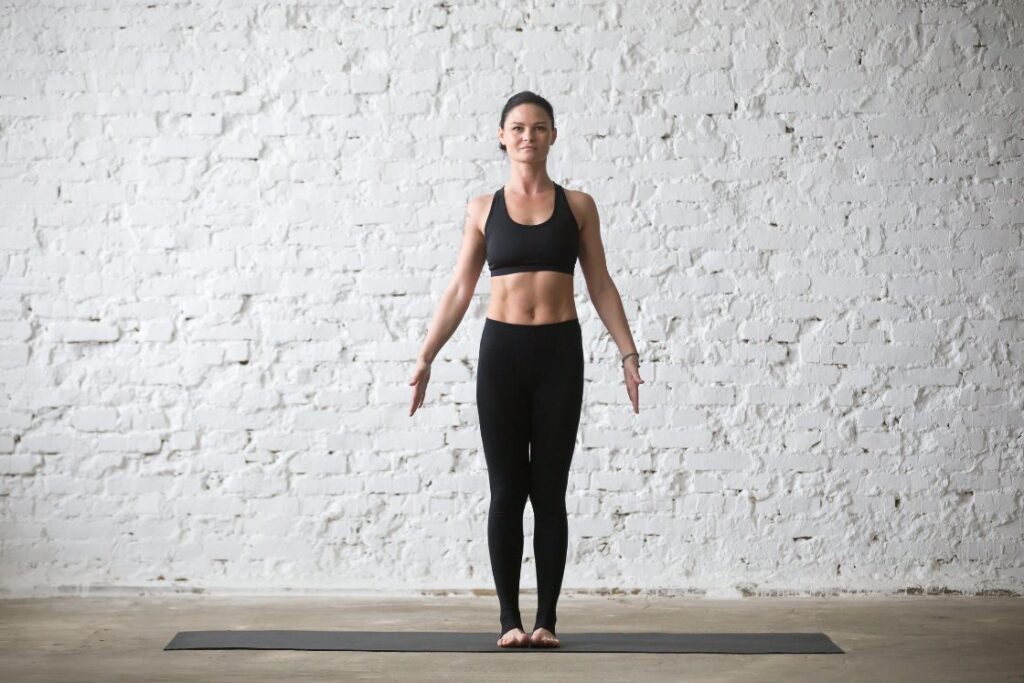
Mountain pose, or Tadasana in yoga, can be effective for scoliosis by promoting better posture and alignment. It encourages individuals to become aware of their posture, which is crucial for those with scoliosis.
This pose also works the core muscles, strengthens muscles along the spine, and promotes balance, which can reduce the risk of falls due to scoliosis-related gait disorders..
Procedure
- Begin with standing tall keeping the heels slightly apart and bringing the big toes together.
- Extend your arms by the sides of your body keeping the shoulders relaxed pulled away from the ears.
- Lift up to your feet’s ball and then toes to find balance and then flatten your feet to evenly distribute the weight across the four corners of the feet.
- Lift your pelvic bone slightly towards the navel keeping the knees soft.
- Relax the facial muscles keeping the chin parallel to the floor. Hold the pose with normal breathing.
3. Tree Pose
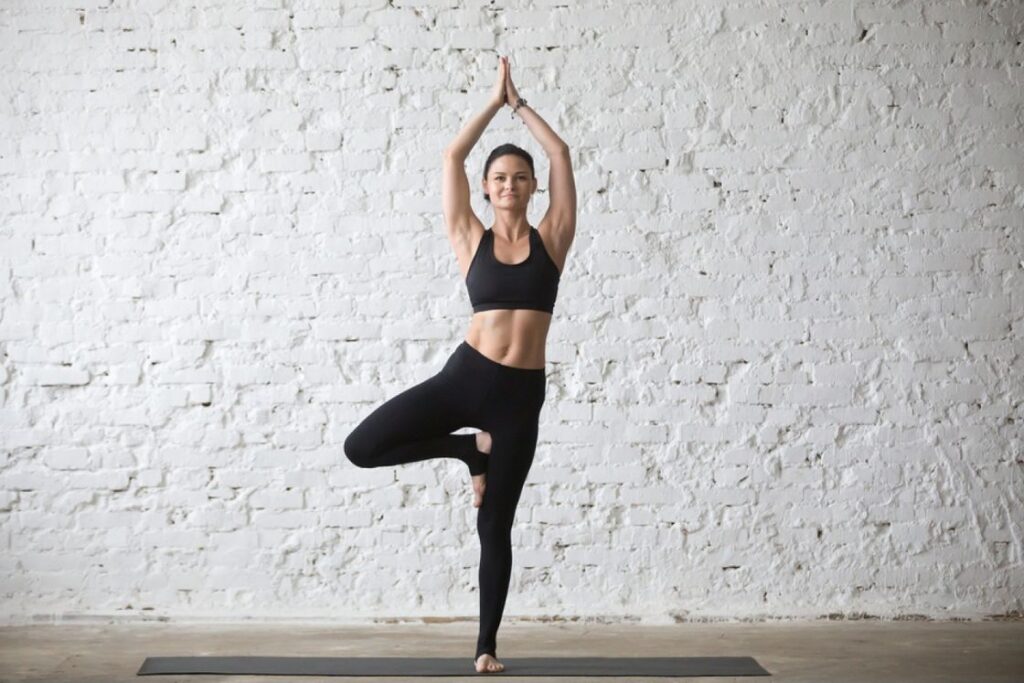
Tress pose is practice balancing the body while standing on one leg and placing the lifted foot on the alternate inner thigh.
This pose for scoliosis is remedial because it focuses on enhancing the core strength eventually building the spinal support. It also subtly stretches the spine that is beneficial for scoliosis patients.
Procedure
- Start with assuming the mountain pose and then shift your bodyweight towards the left leg.
- Lift your right foot bending the right knee towards the right.
- Grab your right ankle with your hands to place the sole of the foot on the left inner thigh as close to groin as possible.
- Focusing on your spine, draw your pelvic bone inward and point your tailbone to the floor.
- Join your palms in front of the chest in prayer pose moving the shoulder blades together,
- Stay in the pose gazing forward with steady breathing for a while then repeat it switching the legs position.
4. Cat-Cow Stretch
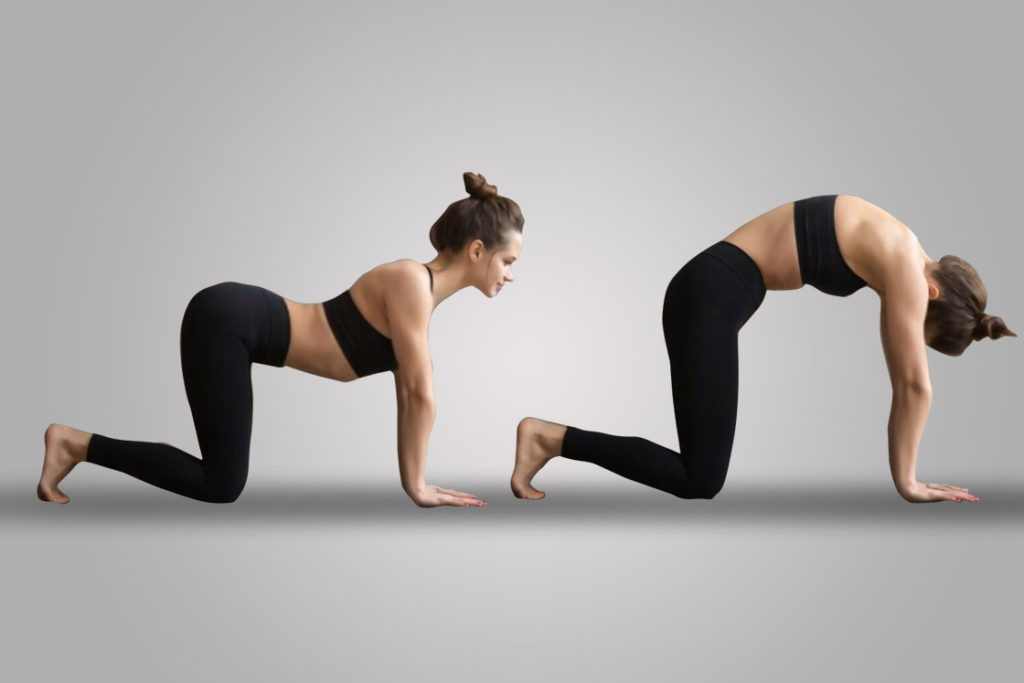
This is a combination stretch for your spinal muscles and tendons. The curling and arching of the spine while switching between cat pose and cow stretch the spaces between the vertebrae opens improves spinal flexibility.
Besides this, it keeps the core muscles engaged as well that also benefits the spine, hence cat-cow is recommended for scoliosis.
Procedure
- Attain a table-top pose coming to your all fours.
- Inhale, pressing your palms against the floor, and using the core strength lift your tailbone and head to arch your lower back in a concave stretch.
- In the cow pose, the heart is opened, shoulders are pulled away from the ears, and the belly sinks to the floor.
- As you exhale, release your neck to lower your head between your arms, and rounding your back tuck your tailbone in to come into cat stretch.
5. Upward Extended Leg Pose
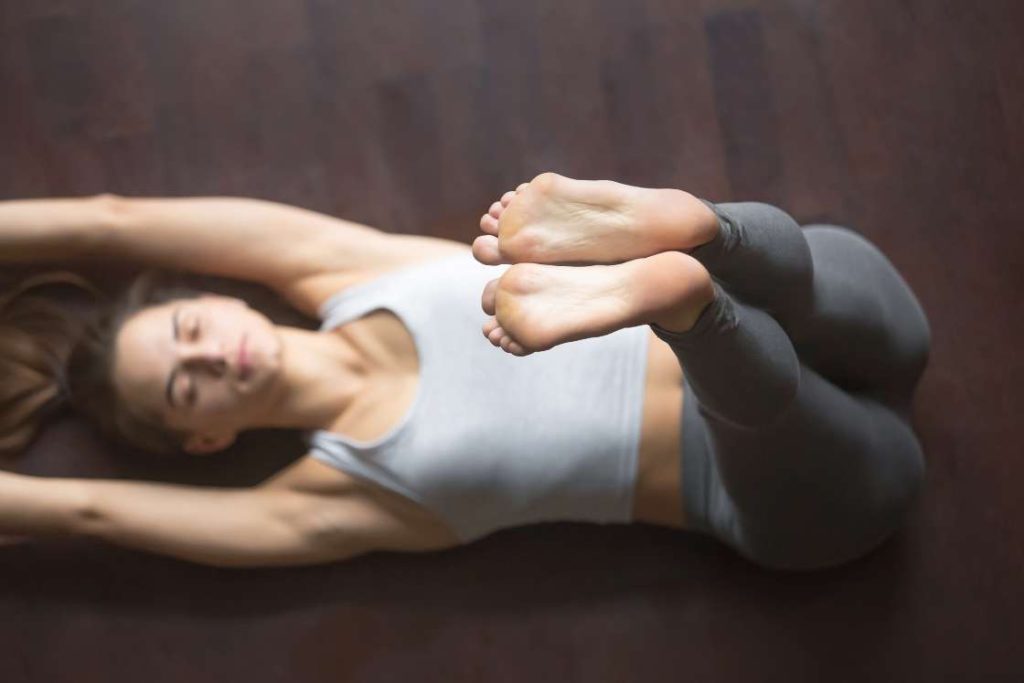
Include this pose into your yoga for scoliosis session because it is practiced easily lying on the floor in a supine position and raising the legs upwards gradually.
This lifting of the legs stimulates the core muscles that protects the spinal muscles from losing their integrity. Thus, it benefits in strengthening both the spine and the core muscles.
Procedure
- Lie on your back on the floor keeping the arms by the sides or overhead.
- Stretch your legs stretch keeping toes flexed.
- Inhale drawing your arms over the head on the floor keeping the palms shoulder-width apart.
- Exhale while tucking the chin slightly towards the chin to stretch the neck and back.
- Inhale to lift the legs off the floor to 90-degrees.
- Stay in the pose for 3-4 normal breaths.
- Exhale to lower your legs and arms back to the initial pose and repeat it 3-4 times.
6. Cow-Face Pose
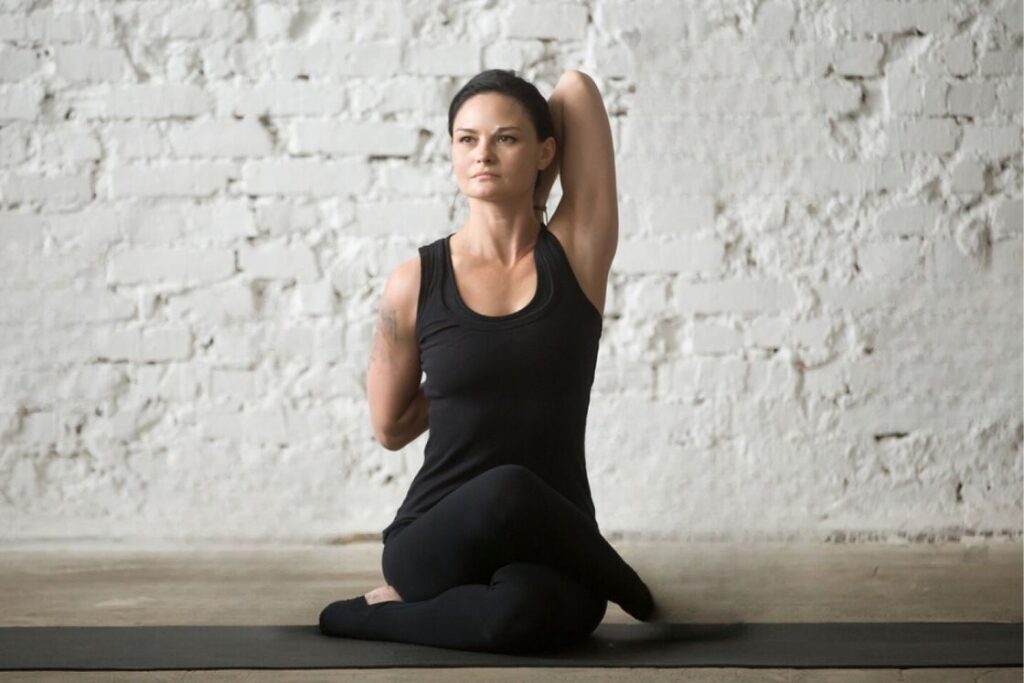
Cow face pose, also known as gomukhasana, is practiced in a sitting posture keeping the back straight and bending the arms at the elbows such that right elbow point upwards while the left point downwards.
The fingertips are then clasped around the upper back with right palm facing the back while the left palm facing outwards. This stretches the upper back and builds strength of this region which might have become weak due to scoliosis.
Procedure
- Sit with an erect back extending the legs in front and arms by the sides of the body placing the palms on the floor.
- Bend your right knee and draw your right foot close to your left buttock.
- Bend the left knee to place the left thigh over the right thigh. Stacking both the knee on top of each other and place the left foot near the right buttock.
- Raise your left arm over head and bending the elbow place your left hand behind the back near the left shoulder.
- Bending you right elbow from below take the right hand to the back and clasp both the fingertips stretching the shoulders and elbows.
- Stay in the pose for a few breaths then release the pose to repeat it switching the legs and arm position.
7. Half Forward Bend
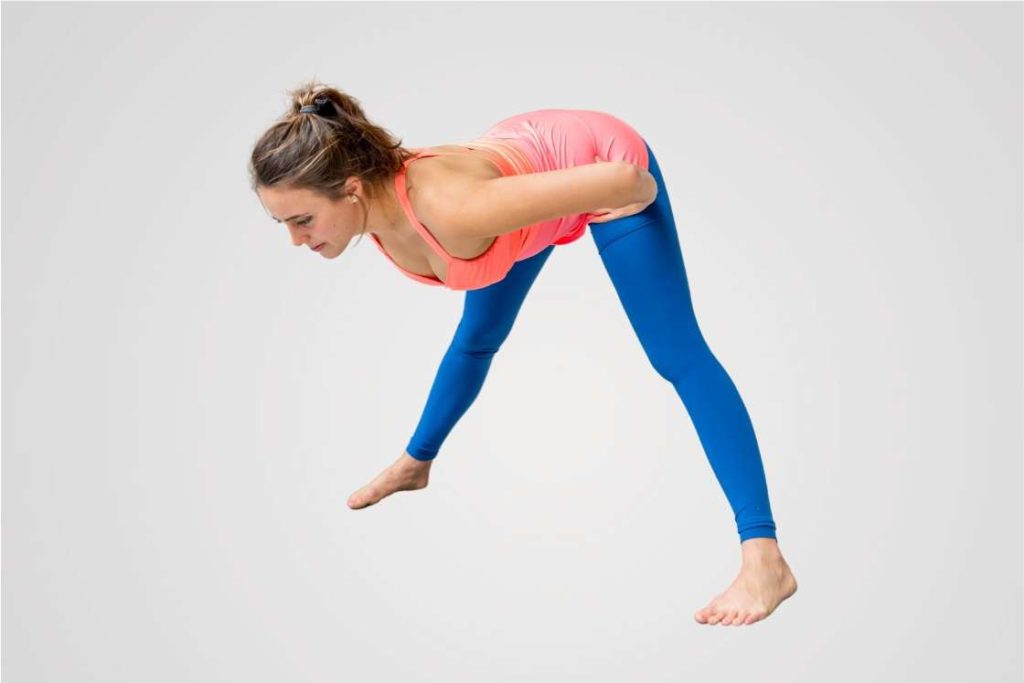
This is a bending pose that brings the spine horizontally parallel to the floor while standing on the feet and extending the arms forward.
Scoliosis patients have poor spinal alignment and posture. Practicing half forward bend for scoliosis lengthens the spine and sides of the body that can rectify the spinal misalignment.
Procedure
- Stand tall keeping the legs together and arms by the sides of the body.
- Inhale to raise the arms overhead and while your exhale bend forward at the hips, pushing the buttocks back, and keeping the back straight.
- Bend until the back becomes parallel to the floor and fingertips point forward.
- While bending forward you can also place your palms against a wall.
8. Child pose
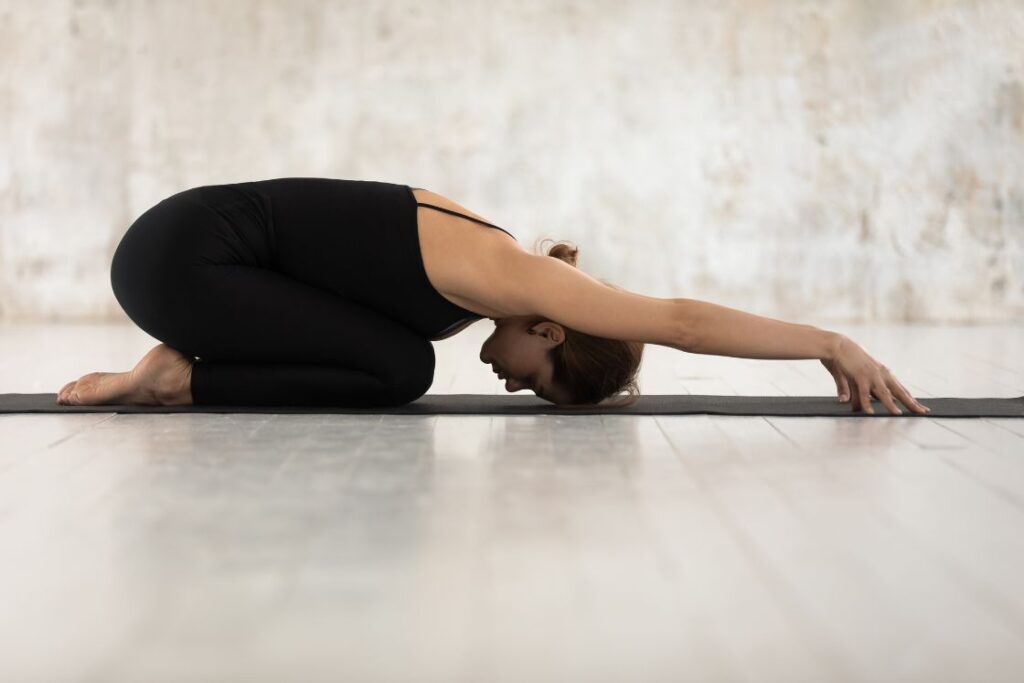
It is a relaxing posture performed by stretching the back in a seated pose folding the legs at the knee, extending arms at the floor, and bringing the forehead to the floor.
Child pose is a restorative pose for scoliosis because it helps lowering the back pain associated with spinal disorientation.
Procedure
- Come to your all fours stacking the wrists under the shoulders and knees under the hips.
- Lower your buttocks to the soles of your feet.
- Extend the arms forward on the floor until the forehead touches the floor.
- Customize your stretch by extending the arms slightly over the right for a right thoracic curve or to the left accordingly.
- Stay in the pose feeling the stretch at the back as long as comfortably possibly with normal breathing.
9. Downward-Facing Dog Pose
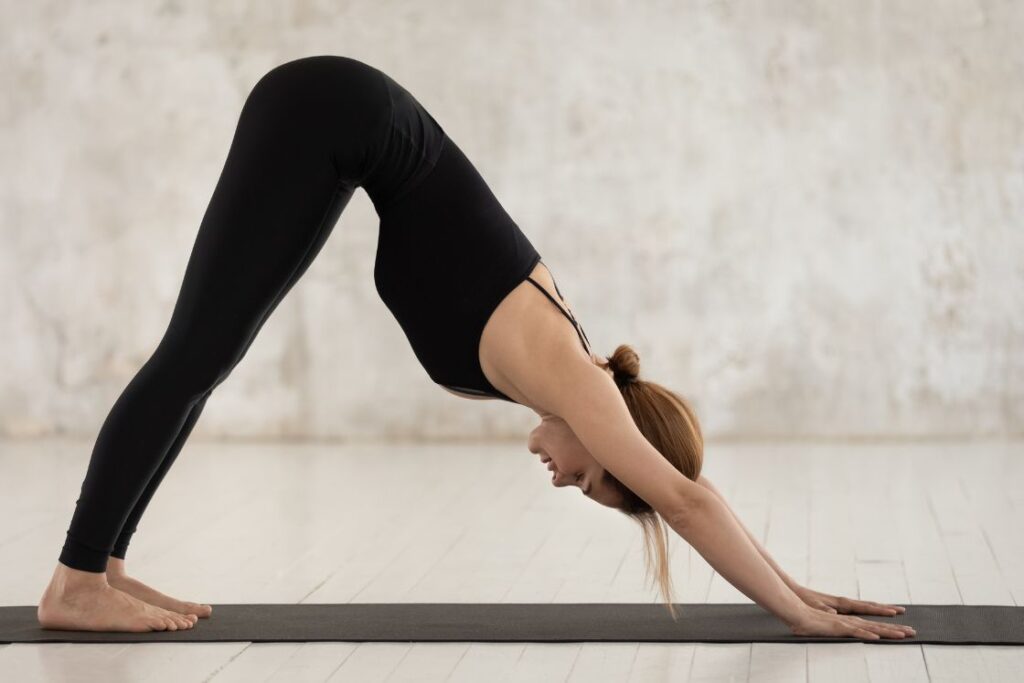
Down-dog Pose brings the torso into an inversion while balancing the body on the hands and legs keeping the core engaged. It stretches the back muscles, arms, and legs.
Scoliosis patients gain benefits from down dog pose as it lengthens the erector spinae muscles and helps in improving the muscular balance. This also strengthens the surrounding muscles of the spine that becomes weak due to scoliosis.
Procedure
- From the table-top position, lift your knees of the floor pressing the palms and toes against the floor.
- Push your buttocks backwards to straighten the legs.
- Lower your head towards the floor between the arms.
- Enhance the stretch by bringing the heels to the floor and gazing towards the navel.
- Stay in the pose for 60 seconds breathing deeply.
10. Side-Reclining Leg Lift Pose
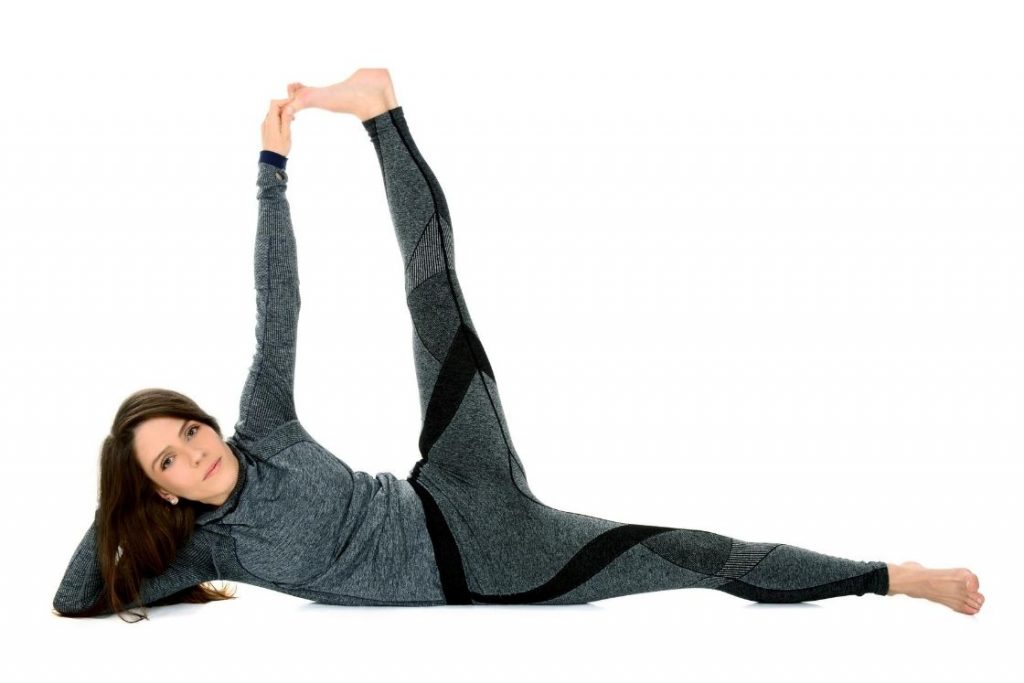
This is an asymmetrical balancing pose practiced lying on one side of the body engaging the core muscles to lift one leg and head off the floor. It stretches the legs and sides of the upper body.
It enhances the balance of the body along with toning and strengthen the core muscles to help with scoliosis.
Procedure
- Lie down on your left side pressing the outer edge of your left foot on to the floor stacking both the legs together.
- Lift your head off the floor and bending your left elbow support your head over the left palm.
- Bend the right knee, extend your right arm to grab the big toe wrapping the thumb, index, and middle fingers of the right hand around it.
- Holding the big toe stretch your right arm and leg straight perpendicular to the floor.
- Hold the pose for a few breaths and then release to repeat it on the other side.
Contraindicated Yoga Poses for Scoliosis
Do not include any yoga poses in your exercising routine that can elevate the symptoms of scoliosis or enhance the progression of the curve. To keep yourself safe from getting hurt or painful discomfort avoid the following poses.
- Avoid shoulder stands or plow pose because they intensely stretch the neck and pressurizes the shoulder muscles. This pose may lead to cervical kyphosis which worsens the alignment of the spine.
- Do not include cobra or bow pose if you have scoliosis because these can worsen scoliosis as it contracts the lumbar spine. It also flattens the thoracic spine leading to destabilization of back muscles and may even cause lordosis.
- Half lord of the fishes pose must be strictly prohibited for patients with scoliosis as it can damage the affected spine by twisting it abnormally.
- Besides these, any poses which include backbend, torso twisting, sideways bending, or bending of the rib cage must be avoided.
Conclusion
Find your way out of scoliosis keeping all the precautions and limitations in mind with the above-mentioned yoga poses. Practicing yoga for scoliosis will help manage, alleviate, and even heal the symptoms in most of the cases of this spinal issue.
You can always turn to these safe poses to improve your spinal health, flexibility, and prevent scoliosis to avoid the misery of such an uncomfortable disorder.
Frequently Asked Questions
Avoid deep back-bending poses, side-bending poses, and twisting poses, as they can destabilize the spine and worsen scoliosis. Inversions, forward bends, and high-impact poses should also be approached with caution or avoided.
Examples of poses to avoid include Cobra Pose, Triangle Pose, Seated Twist, Headstands, Shoulderstands, Paschimottanasana, and any pose involving high-impact movements or excessive stretching.
The frequency of yoga practice varies from person to person. A qualified yoga instructor can help you create a personalized practice schedule based on your specific needs and goals.
Yes, some yoga poses can help improve spinal strength, flexibility, and posture. Poses like Half Forward Bend and Downward-Facing Dog may be beneficial, but it’s essential to consult a professional for guidance.
Yes, activities like swimming, Pilates, and physical therapy exercises can complement yoga in scoliosis management. Consult a healthcare professional for a well-rounded approach.
